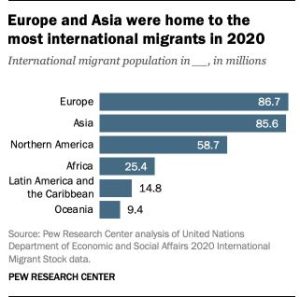Global migration trends identified
Key global trends in migration have been identified in a new analysis of migration data from the United Nations and other sources.
The analysis, by the Washington-based think tank The Pew Research Center, looked at the latest data collected on human movement around the globe.
With number of international migrants growing to 281 million in 2020, representing 3.6 per cent of the world’s people living outside their country of birth that year, the research identified eight key trends in human movement.
*The Pew research found Europe and Asia had the most numbers of international migrants.
Around 86.7 million international migrants lived in Europe in 2020, followed by 85.6 million in Asia. The number of international migrants living in these two regions has steadily increased since 2005, according to the Pew research.
Meanwhile, Latin America and the Caribbean regions has the fastest-growing international migrant population. Since 2005, the region’s international migrant population has doubled.
 In Oceania, the region dominated demographically by Australia, the population of international migrants is the largest as a proportion of the total population.
In Oceania, the region dominated demographically by Australia, the population of international migrants is the largest as a proportion of the total population.
In 2020, 21.4 per cent of all residents in Oceania – which also includes New Zealand and Pacific island nations – were international migrants.
North America is second after Oceania, with migrants making up 15.7 per cent of the population. While in Europe, migrants account for 11.6 per cent of the population. In all other world regions, they represent 2.3 per cent or less of the population.
The UN data also shows international migrants in Gulf Cooperation Council countries, including Bahrain, Kuwait, Oman, Qatar, Saudi Arabia and the United Arab Emirates, make up more than half, or 52.7 per cent, of resident populations – but most of these are temporary migrant workers.
*The US has more international migrants that any other country. With nearly 51 million migrants in 2020, the Pew analysis found.
Germany has the second largest migrant population with about 15.8 million migrants, followed by Saudi Arabia with 13.5 million.
*India is the top origin country for the world’s migrants. India has been a major source of international migrants for more than 100 years.
 In 2020, 17.9 million international migrants traced their origins back to India, followed by Mexico with about 11.2 million and Russia with about 10.8 million.
In 2020, 17.9 million international migrants traced their origins back to India, followed by Mexico with about 11.2 million and Russia with about 10.8 million.
India’s migrants are dispersed around the world, but the countries with the largest Indian migrant populations are the United Arab Emirates (3.5 million), the U.S. (2.7 million) and Saudi Arabia (2.5 million).
Though India is the single largest source of international migrants, its 17.9 million migrants in 2020 accounted for only 1.3 per cent of all people born in India by that year.
*Remittances – the money that migrants send to their home countries – decreased by about $US11 billion from 2019 to 2020 as the coronavirus pandemic arrived, the Pew report showed.
Global remittances had been steadily increasing since 2010, but they fell from $US722 billion in 2019 to $US711 billion in 2020.
According to the World Bank, remittances reached $US781 billion in 2021 and are estimated to reach $US794 billion in 2022, both record highs.
*India has been the world’s top receiver of remittances since 2010. Remittances to India grew from $US53 billion in 2010 to $US89 billion in 2021.
The US has been the top sending country for remittances since 1990, the earliest year with available statistics. In 2021, international migrants living in the US sent $US73 billion in remittances globally.
*The number of displaced people in the world rose to a new high of 89.4 million in 2020, the Pew analysis found.
Displaced people are refugees, asylum seekers or internally displaced people forced to leave their homes due to conflict, violence or disasters.
Overall, the number of displaced persons rose from 84.8 million in 2019 to 89.4 million in 2020, according to UN data.
Overall, about 1.1 per cent of the world’s population are displaced people.
Among the world’s displaced people, about 34 per cent, or 30.5 million, were living outside their country of birth as refugees (26.4 million) or asylum seekers (4.1 million) in 2020.
An additional 3.9 million displaced Venezuelans who have not applied for refugee or asylum status lived outside of Venezuela in 2020. The majority of displaced people, 55 million, were internally displaced in their birth countries because of conflict, violence or disasters.
*The share of international migrants who are men has risen in recent decades, the Pew study showed.
In 2000, 50.6 per cent of international migrants were men and 49.4 per cent were women. By 2020, men made up 51.9 per cent of global migrants while 48.1 per cent were women, according to estimates by the United Nations.
*The majority of the world’s international migrants lived within their region of origin in 2020.
While some migrants may go to new regions of the world, a majority (54.9 per cent) lived within their region of origin in 2020.
But international migration within regions still varies widely. For example, 69.9 per cent of Europe’s international migrants resided in another European country in 2020, reflecting migration out of Eastern European countries such as Russia, Ukraine, Poland and Romania to Western European ones.
International migrants in Asia and Oceania are the next most likely to live in their region of origin at 59.6 per cent and 56.2% per cent, respectively. Migrants from Africa are about as likely to live within Africa as they are to live outside of the continent (51.6 per cent vs 48.4 per cent).
Read the full Pew report here: Key facts about recent trends in global migration | Pew Research Center












